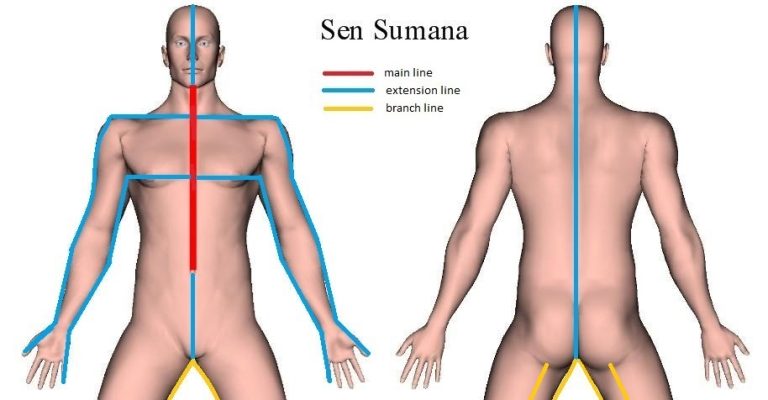
When we try to provide accurate descriptions, functions, charts, locations, and trajectories of the Yoga Nadis, we really embark on a complicated task, and it puts us for several difficulties.
There are, for instance, different names for the same Nadis; think of Ida Nadi, which is also called Chandra Nadi. Or, Pingala Nadi, also labeled Surya Nadi. And Sushumna Nadi, which actually seems to consist of three inner channels and is sometimes called Brahma Nadi after its most inner subtle Prana channel.

Another thing is the phonetic translation of the Sanskrit and Hindi language in the Romance alphabet (or Latin alphabet). For instance, Hastijihva Nadi is also written as Hastajihva Nadi or Hasti Jeeva Nadi. Or, Pusha Nadi, which can also be found written as Pusa Nadi, Pushaa Nadi, or Poosa Nadi. Not to talk about errors and typos in manual copies of texts, or regional differences in languages and dialects.
But were the issues only the above, we could have probably found our way without too many difficulties. Yet, perhaps of more confusion is the fact that different authoritative and classical Indian Yoga Gurus, ancient sources and texts more often than not give us different descriptions of Nadi trajectories and locations in the body, subsequently resulting in different visual charts or maps.
Moreover, often only the starting, intermediary, and/or ending points of the Nadis are described, and not the actual pathways i.e. trajectories through the body that connect them, which has given rise to many different assumptions and interpretations.
Even Ida Nadi and Pingala Nadi, two of the best researched Nadis, are sometimes explained with having end points that differ from the most commonly accepted ones. Perhaps most notable is the description of the Great Sage Shri Adi Shankaracharya who writes in the Prapanchasara Tantra (8th century CE) that Ida Nadi ends in the right nostril and not in the left (the latter being the most common assumption).

To give you a further idea of the issues that play here, check out the following description in an ancient Yoga source: “Gandhari Nadi is behind Ida Nadi to one side and ending at the edge of the left eye.” And another example: “Sankhini Nadi is located in the eyes and ends at the genitals.” You’ll probably agree with me that such ways of describing a trajectory or location of a Nadi is rather “cryptic,” to say the least.
Additionally, the ancient sources on Yoga span a considerable stretch of time, that is, at least 2,000 years. Different authoritative texts are referenced to give a description of the Nadi trajectories and functions, such as the Darshana Upanishad, Varaha Upanishad, and Kshurika Upanishad (which are only 3 texts of a total of 20 Yoga Upanishads), the Yoga Sutras of Patanjali, the Sat Chakra Nirupana, the Hatha Yoga Pradipika, the Shiva Samhita, and the Gheranda Samhita, among other classical texts.
In fact, it’s almost certain that textual transmissions were sometimes erroneously translated or were differently interpreted, or even deliberately changed because of new insights that came about across the centuries.
Another thing is that, in the past in India (and in Asia in general), transmission of knowledge was largely done through speech (orally), and written texts may sometimes have only been produced as “pointers” or summaries. That is, detailed knowledge was often only transmitted orally and directly from master (Guru) to student.
What makes things even more complicated is that the Nadis are invisible to the eyes or to measuring equipment. As it is, it’s often said that the Nadi trajectories have been “seen,” “visualized,” or “energetically felt” by advanced Yoga Gurus and Sages in deep meditation sessions.

Differences in Nadi trajectories and charts may also have been the result of focusing on different therapeutic aspects or functions. To give an example of what this means: a map or chart of a certain city may focus on rivers or streets or maybe only on restaurants and hotels. So, depending on the aim of the map or chart the resulting trajectories are depicted i.e. drawn differently.
The contradictions and ambiguities of intermediary and/or termination points for the same Nadis may also be the result of some classical texts mentioning certain points of major branches or extensions of a specific Nadi, and others omitting those.
Interesting enough, we sometimes can get a better grasp of the trajectories of the Nadis by studying the Thai Sip Sen Energy Lines. These Sip Sen (or ten channels) are predominantly derived from the Yoga Nadis (sometimes even having almost the same names), and in many cases they describe the trajectories they follow through the body in much more detail.
But all by all, the exact functions and trajectories of the Yoga Nadis, even those of the fourteen principal Nadis, remain a kind of speculation and interpretation. It will most likely never be possible to know the indisputable “truth” about them, if there is a truth at all.















